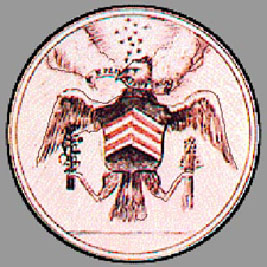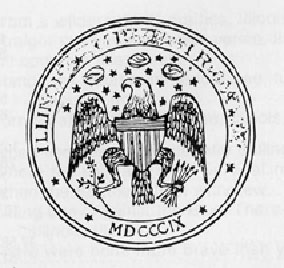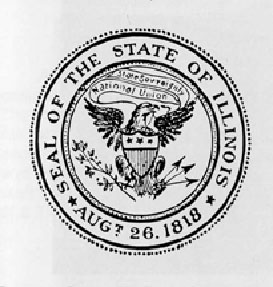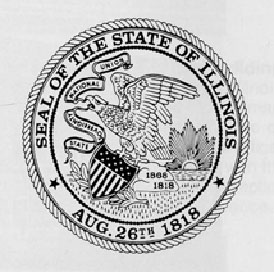State Symbol: Illinois State Seal
History of the State Seal of Illinois

Territorial Seal
Illinois was part of the US territory northwest of the Ohio River until 1809, when it became the Territory of Illinois. The governor and judges decided to create a territorial seal. They chose a design based closely on the earliest seal of the United States. There are only a few impressions of this seal still existing, and the image is fuzzy.

First State Seal
In 1818, Illinois was admitted to the Union. The next year the First General Assembly enacted a law that stated the Secretary of State had the duty to create a seal to be agreed upon by the Governor and Supreme Court Justices. This was done and the state adopted a new seal in 1819. It, too, was based on the Great Seal of the United States.The parts of the
seal's design are:
1.the escutcheon (shield), which is made up of a striped section
(sometimes 13 stripes) representing the states, and the chief (a
bar section across the top) that represents the Congress and unity of
the states. The colors are white (purity, innocence); red (valor and hardiness);
and blue (vigilance, perseverance, justice).
2. Constellation
of stars, (sometimes 13 stars) representing a new state taking its
place among others. In some seals the stars are bursting out of the clouds.
3. American eagle, which is the symbol of the United States.
4. Olive branch and arrows, representing war and peace, which are
powers of Congress (in some versions of the seal there are 13 arrows)

This seal was used until 1839, when it was recut by the then current Secretary of State.
The Second Seal
The second seal resembled in style the seal of the Masi Treaty, which was struck in 1825. Note the eagle has been reversed and its wings are pointed skyward. The constellation is gone, but three stars are now on the chief. There are only three arrows left in the eagle's talons. The number of stripes on the escutcheon are not thirteen. This number symbol has disappeared.
Seal of 1868

In 1868, a bill was introduced to create a new seal. It went though the legislature attracting the attention of only a few individuals, but the final bill said the seal was to remain essentially like the original. However, its written description fit the seal that had been used on official stationery rather than the 1839 seal: “American Eagle on a bowlder in prairie, the sun rising in distant horizon”
The motto, “State Sovereignty, National Union,” was controversial after the Civil War, when national unity was considered paramount. While the legislature commanded that the motto stay the same, the new design twisted the scroll in a way that put National Unity at the top.